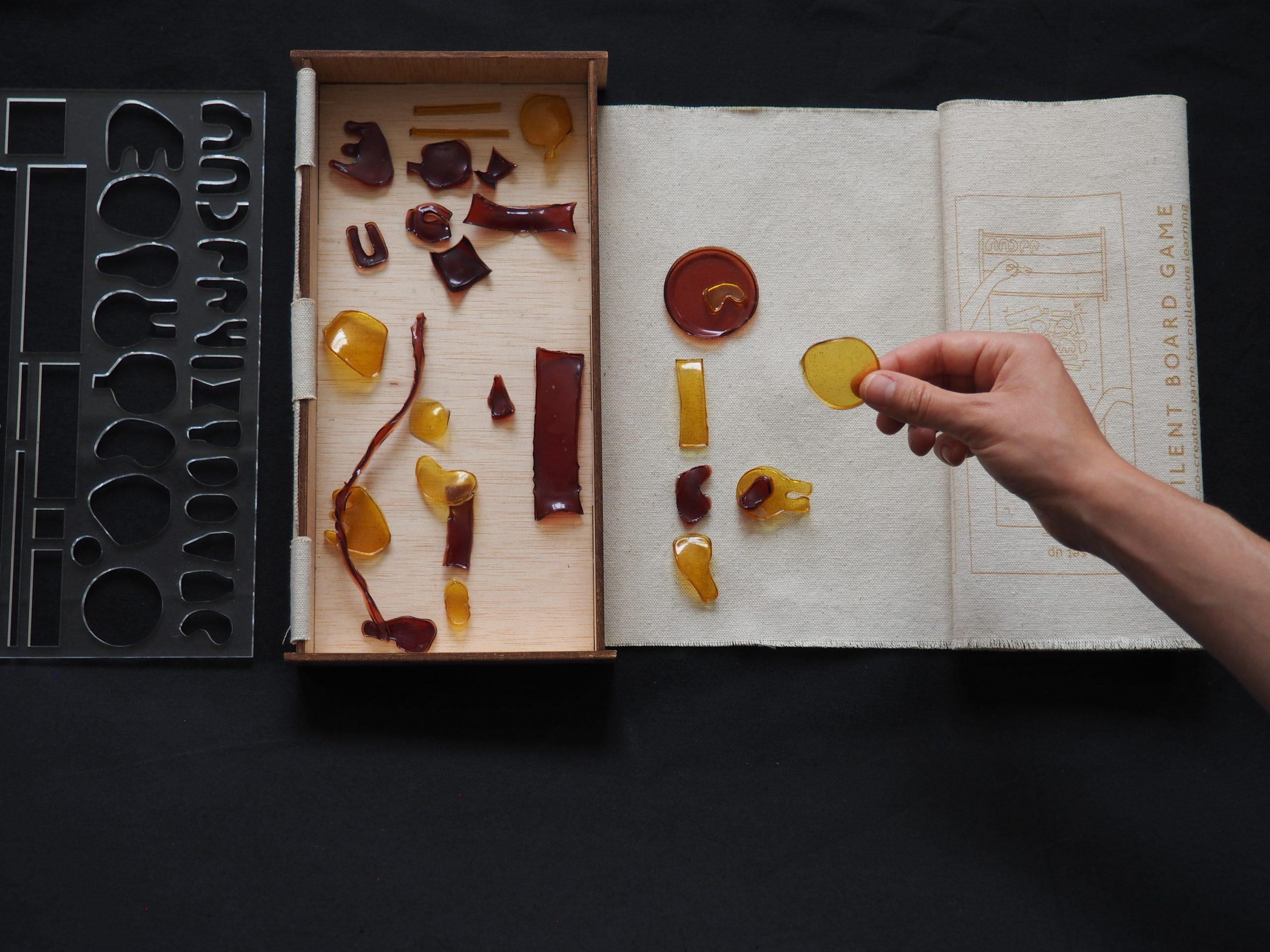Silent Board Game
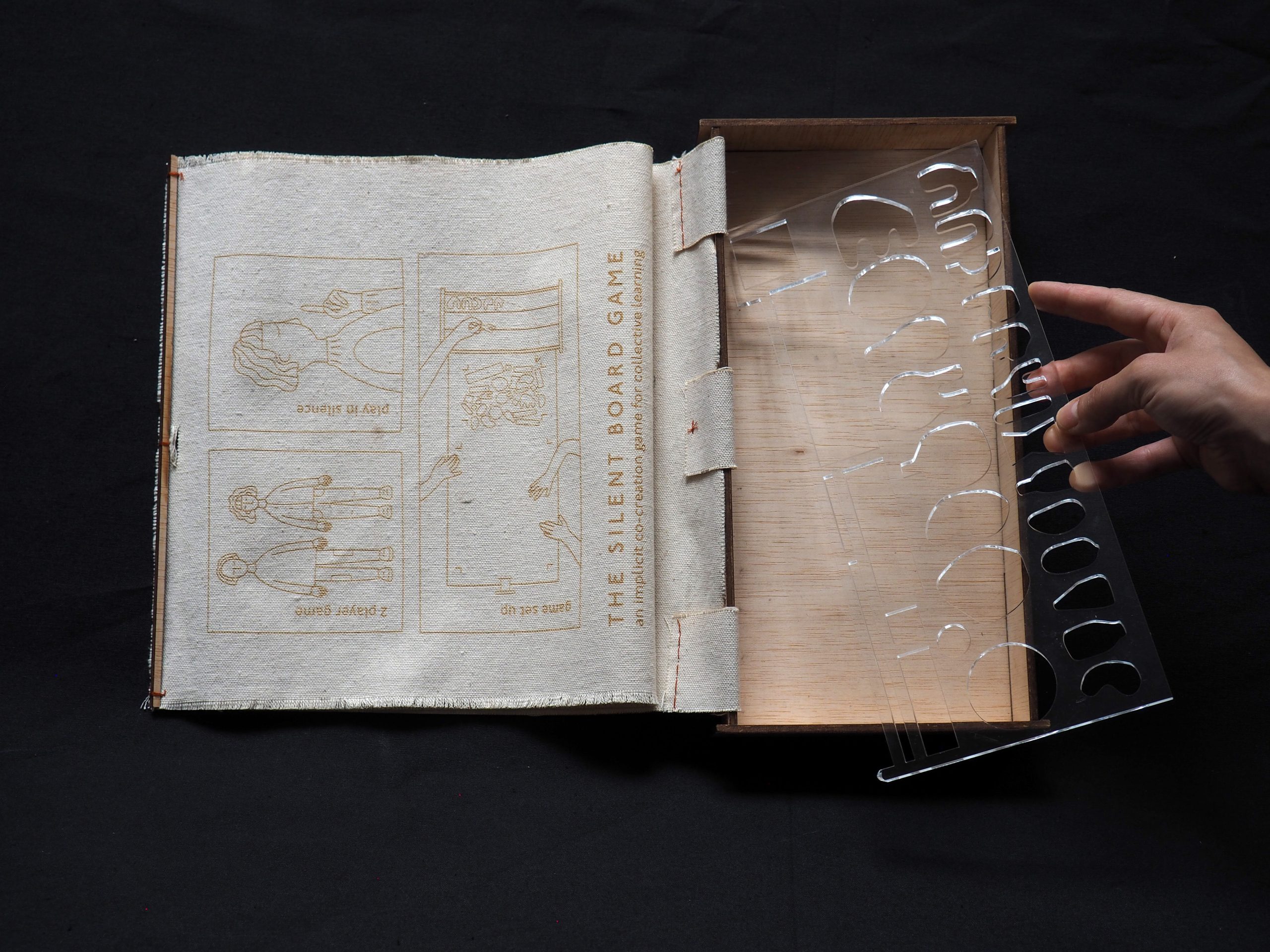
Useful information
- Team members
- Morgane Shaban Ines Burdiles
- Country
- Spain
- Keywords
- Co-creation Playful Education Responsible Creativity Biomaterials Circularity
Short Description
A playful tool to reinforce values of implicit communication and cocreation in learning environments
Detailed Description
The Silent Board Game is a physicalization proposal of the Silent Game, originally created by Habraken & Gross at MIT, published in the book “Concept Design Games” in 1987. The board is designed to be deployed in creative learning environments to reinforce values of implicit communication and co-creation through the arrangement of pieces of different shape, size and colour, as patterns in space, through the act of playing. The Silent board game creates a space for interaction through new forms of communication with a co-player. The game enables a collaborative exercise that promotes recognition and respect for the other, and material literacy. The first pieces of the board are produced by a laser cutter. The pieces are then contained in a press-fit box and canvas wrap which has engraved instructions upon it. Inside, you can also find the ‘Generator’. The generator allows the players to create their own pieces with DIY cooked biomaterials (the pieces and generator can be customised).
Project Details
- Does your design take social and cultural challenges and human wellbeing into consideration?
The social and cultural challenges we face today demand collaboration and respect from others to achieve consistent and meaningful change. The Silent board game is a playful tool to learn through co-creation, and integrate the values of responsible creativity inclusively. Exercising implicit communication through body language - rather than explicit verbal communication - the game enables cross cultural universal connections with other humans, focusing on our similarities rather than the differences. It frames the setting for the emergence of empathy, openness and respect towards others and otherness. The game encourages shifting attitudes towards the importance of play, understanding it as a mechanism of learning rather than a competitive setting. The Silent Game does not have a winner, but rather ends with a co-created artifact. In the words of Frost regarding ‘play’, It proposes a model that encourages independent thinking, environment building, provides opportunities to practice new skills, promotes problem solving and develops a creative intelligence (Frost, 2006).
- Does your design support sustainable production, embodying circular or regenerative design practices?
The design considers the use of locally available materials. What is produced in a more formal maker environment are the basic box, wrapper and the generator, made out of locally produced wood and fabric. The actual pieces of the game are to be produced by the players. This action gives the players -through learning by making- the chance to question the origin and destiny of the everyday material reality humans interact with. The pieces of the game are highly local, come from home cooking waste, that properly dried and shredded give excellent quality fillers for the biomaterials. The polymers to be used are suggested to be agar agar or gelatine, and the plastifier suggested is alimentary glycerine. These pieces have their own lifecycle, timescale and afterlife. As pointed out by Morgane Sha’ban in her thesis, the more the game is used, the more it will evolve as the pieces get lost, broken, deformed and remade. “Being made of almost all organic materials (plywood and biomaterials) the pieces can be recycled or biodegraded.” The end of the life is considered as an important part of the design. Only “the generator” that is made of acrylic will remain. “This is the everlasting artifact that could always be a way to resurrect the game and make more pieces.” (Sha’ban, 2021).
- Does your design use principles of distribution and open source?
Designed at and in collaboration with Fablab BCN, the design is considered to be adaptable to different deploying scenarios and its highly local approach can allow for fabrication with different available materials. Anyone with access to a sheet of any kind of wood, a laser cutter and a kitchen, can make their own version of the silent board game. For precise information and applicability, an open source repository has been created and updated with the evolutions of the project. The game itself has very simple and basic rules, this is also a feature of the high adaptability and customisation of the game itself. So far the game has been tested in a Montessori School in Barcelona, where the children have already started giving the game their own rules, expanding on the basic ones. The simplicity of the instructions that are given, present a foundation to the game, where the players can always break away from the given objects or given instructions (Sha’ban, 2021). Repo found here: https://gitlab.com/morgane_shaban/silent-board-game.git
- Does your design promote awareness of responsible design and consumption?
The principles of human wellbeing can be translated to planetary wellbeing. Through embodied circularity, and the promotion of creation using responsible materials with a determined life cycle - that allows for recycling, repairing and/or biodegradation and composting - the project invites young generations to take care of the planet. It promotes the direct relation that planetary wellbeing has with the careful and responsible manipulation of resources in the becoming of objects and things, that as humans we make. The artifact presents to the young two very simple questions, Where does the matter come from/ start? and Where does it go when we throw it away? The game is also an example that everything can be a tool for play. People, especially children will find anything and will start investigating and playing with it. The Silent Board Game uses everyday objects and waste to make playful interactions and inventions.
Images

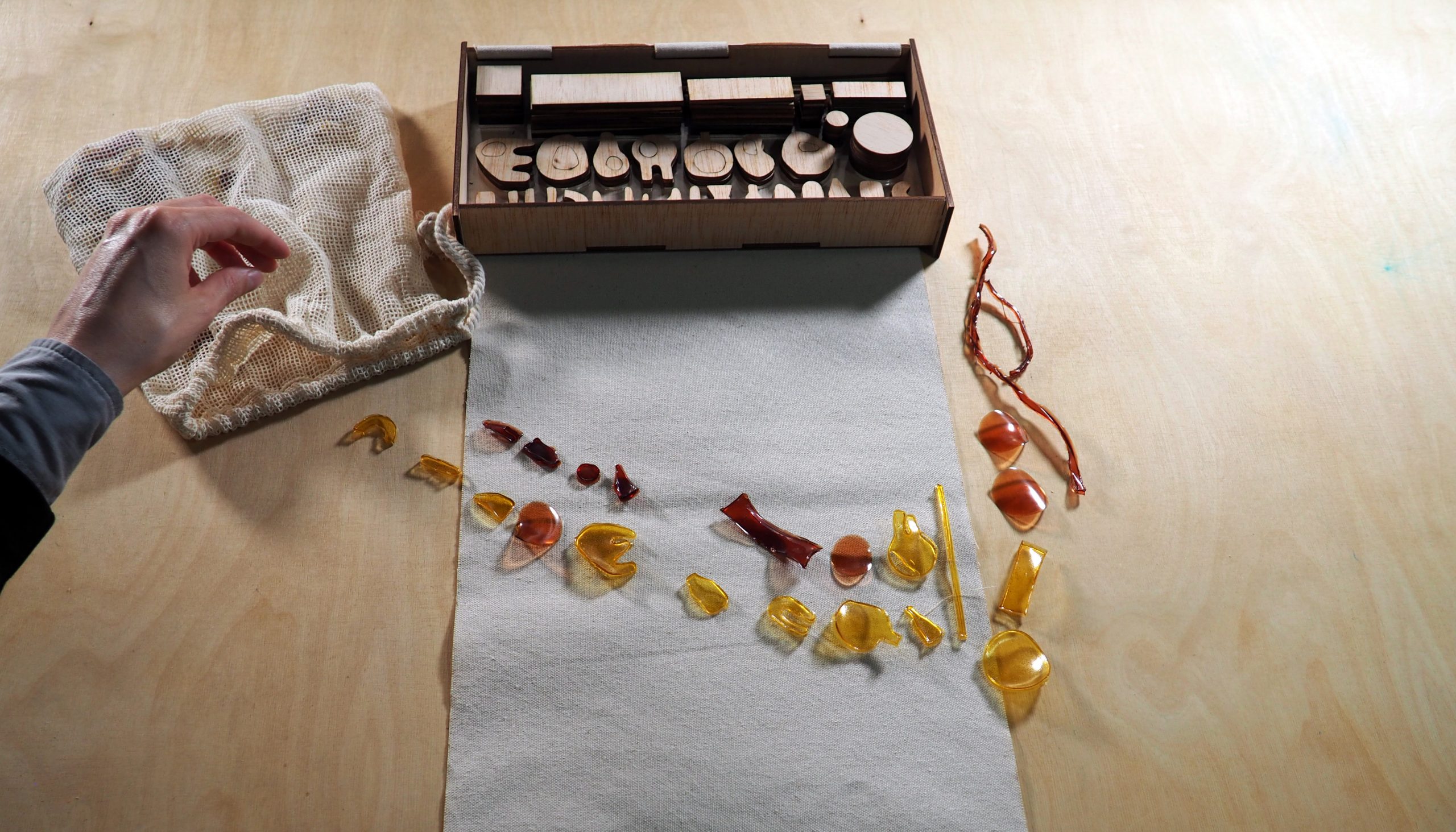
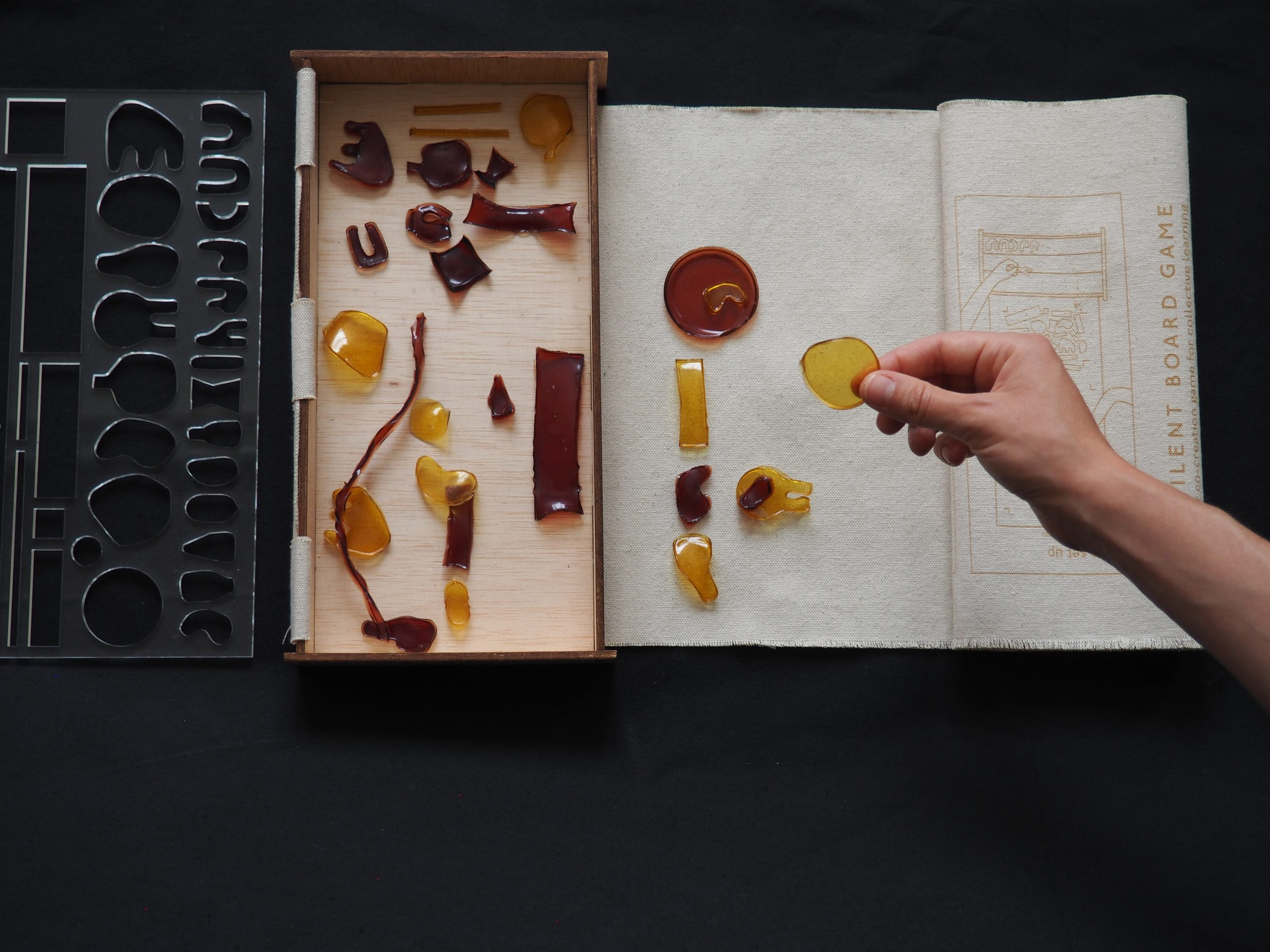
Video
Project Website
Social Media Accounts
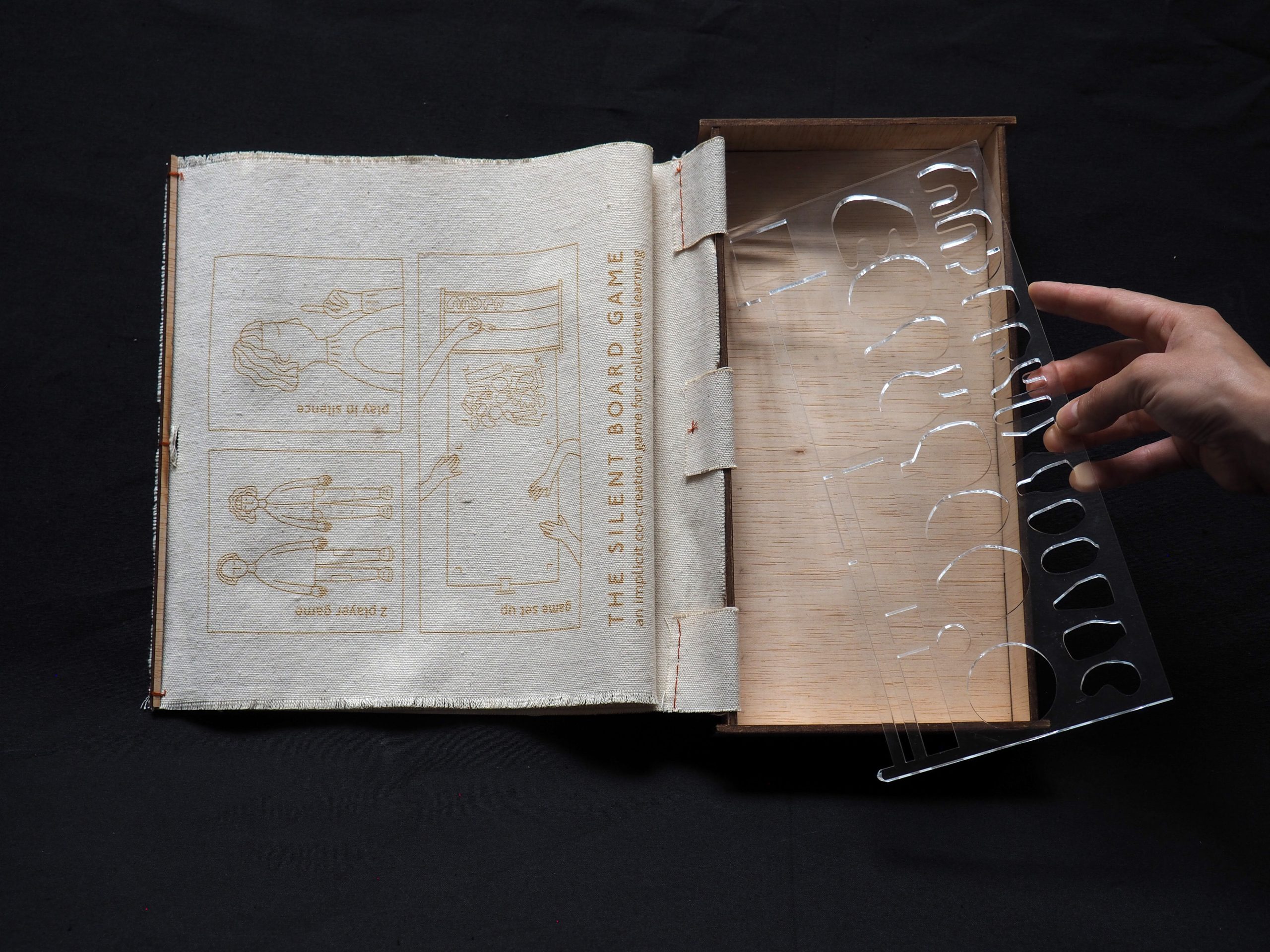
Useful information
- Team members
- Morgane Shaban Ines Burdiles
- Country
- Spain
- Keywords
- Co-creation Playful Education Responsible Creativity Biomaterials Circularity
Short Description
A playful tool to reinforce values of implicit communication and cocreation in learning environments
Detailed Description
The Silent Board Game is a physicalization proposal of the Silent Game, originally created by Habraken & Gross at MIT, published in the book “Concept Design Games” in 1987. The board is designed to be deployed in creative learning environments to reinforce values of implicit communication and co-creation through the arrangement of pieces of different shape, size and colour, as patterns in space, through the act of playing. The Silent board game creates a space for interaction through new forms of communication with a co-player. The game enables a collaborative exercise that promotes recognition and respect for the other, and material literacy. The first pieces of the board are produced by a laser cutter. The pieces are then contained in a press-fit box and canvas wrap which has engraved instructions upon it. Inside, you can also find the ‘Generator’. The generator allows the players to create their own pieces with DIY cooked biomaterials (the pieces and generator can be customised).
Project Details
- Does your design take social and cultural challenges and human wellbeing into consideration?
The social and cultural challenges we face today demand collaboration and respect from others to achieve consistent and meaningful change. The Silent board game is a playful tool to learn through co-creation and integrate the values of responsible creativity inclusively. Exercising implicit communication through body language - rather than explicit verbal communication - the game enables cross cultural universal connections with other humans, focusing on our similarities rather than the differences. It frames the setting for the emergence of empathy, openness and respect towards others and otherness. The game encourages shifting attitudes towards the importance of play, understanding it as a mechanism of learning rather than a competitive setting. The Silent Game does not have a winner but rather ends with a co-created artifact. In the words of Frost regarding ‘play’, It proposes a model that encourages independent thinking, environment building, provides opportunities to practice new skills, promotes problem solving and develops a creative intelligence (Frost, 2006).
- Does your design support sustainable production, embodying circular or regenerative design practices?
The design considers the use of locally available materials. What is produced in a more formal maker environment are the basic box, wrapper and the generator, made out of locally produced wood and fabric. The actual pieces of the game are to be produced by the players. This action gives the players -through learning by making- the chance to question the origin and destiny of the everyday material reality humans interact with. The pieces of the game are highly local, come from home cooking waste, that properly dried and shredded give excellent quality fillers for the biomaterials. The polymers to be used are suggested to be agar agar or gelatine, and the plastifier suggested is alimentary glycerine. These pieces have their own lifecycle, timescale and afterlife. As pointed out by Morgane Sha’ban in her thesis, the more the game is used, the more it will evolve as the pieces get lost, broken, deformed and remade. “Being made of almost all organic materials (plywood and biomaterials) the pieces can be recycled or biodegraded.” The end of the life is considered an important part of the design. Only “the generator” that is made of acrylic will remain. “This is the everlasting artifact that could always be a way to resurrect the game and make more pieces.” (Sha’ban, 2021).
- Does your design use principles of distribution and open source?
Designed at and in collaboration with Fablab BCN, the design is considered to be adaptable to different deploying scenarios and its highly local approach can allow for fabrication with different available materials. Anyone with access to a sheet of any kind of wood, a laser cutter and a kitchen, can make their own version of the silent board game. For precise information and applicability, an open-source repository has been created and updated with the evolutions of the project. The game itself has very simple and basic rules, this is also a feature of the high adaptability and customisation of the game itself. So far the game has been tested in a Montessori School in Barcelona, where the children have already started giving the game their own rules, expanding on the basic ones. The simplicity of the instructions that are given, present a foundation to the game, where the players can always break away from the given objects or given instructions (Sha’ban, 2021). Repo found here…. https://gitlab.com/morgane_shaban/silent-board-game.git
- Does your design promote awareness of responsible design and consumption?
The principles of human wellbeing can be translated to planetary wellbeing. Through embodied circularity, and the promotion of creation using responsible materials with a determined life cycle - that allows for recycling, repairing and/or biodegradation and composting - the project invites young generations to take care of the planet. It promotes the direct relation that planetary wellbeing has with the careful and responsible manipulation of resources in the becoming of objects and things, that as humans we make. The artifact presents to the young two very simple questions, Where does the matter come from/ start? and Where does it go when we throw it away? The game is also an example that everything can be a tool for play. People, especially children will find anything and will start investigating and playing with it. The Silent Board Game uses everyday objects and waste to make playful interactions and inventions.
Images


